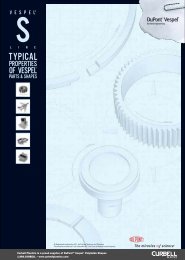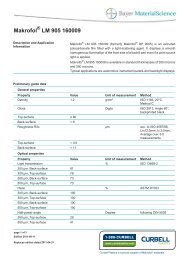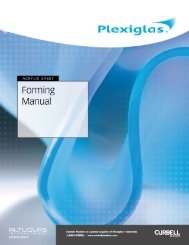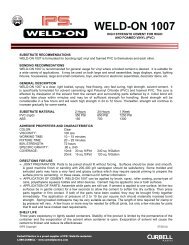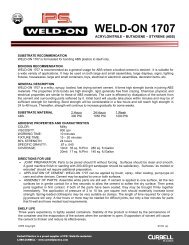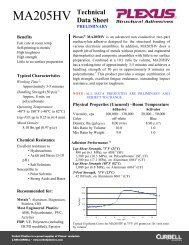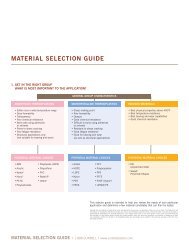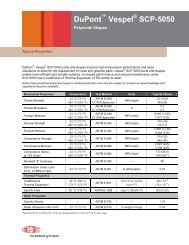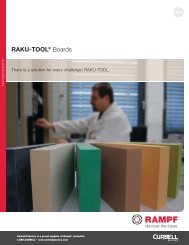Mustang Sheet Fabrication Guide - Curbellplastics.com
Mustang Sheet Fabrication Guide - Curbellplastics.com
Mustang Sheet Fabrication Guide - Curbellplastics.com
- No tags were found...
You also want an ePaper? Increase the reach of your titles
YUMPU automatically turns print PDFs into web optimized ePapers that Google loves.
FormingLine BendingLine bending, also known as strip heating, is atechnique used for forming sharp bends in theplastic sheet. When heated properly, <strong>Mustang</strong> lendsitself well to this type of fabrication. The radius ofthe bend can be controlled by the width of theheated area. The temperature of the side oppositeof the heat source should be heated to ≥250° Fprior to bending. This will assist in eliminating theresidual stress that can form when bending at atemperature that is too cold. Thicker sheets shouldbe heated from both sides to achieve a uniformheating through the sheet. Heat perpendicular tothe manufacturer’s extrusion direction to reduce thepossibility of warpage in the heated areas. Alwaysstabilize the sheet by clamping during the heatingand cooling processes.Oven Heating<strong>Mustang</strong> sheet should be heated in a horizontaloven. It is not conducive to use with vertical ovens.ThermoformingThe term thermoforming refers to the processof heating a plastic sheet to sufficient temperature toform a shaped article. <strong>Mustang</strong> sheet excels in thisarea, offering a unique <strong>com</strong>bination unmatched bypolycarbonate. <strong>Mustang</strong> sheet can be thermoformedwithout pre-drying, forms at lower temperatures,has faster heating and cooling cycles, has excellentmaterial distribution characteristics and processesconsistently. Deep draws and intricate part definitionsare achievable with <strong>Mustang</strong> by using simple vacuumforming techniques.The entire cut to size sheet is typically heated toforming temperature inside an oven. The formingtemperature depends on the thickness of the sheetand the shape or <strong>com</strong>plexity of the mold (See Table2). For less intricate molds, heat <strong>Mustang</strong> sheet onthe lower side of the temperature range. For deeperdraws and more <strong>com</strong>plicated mold designs, heat tothe middle to upper side of the temperature range.Because <strong>Mustang</strong> sheet exhibits great detail, careshould be taken when manufacturing the mold. Itneeds to be smooth. <strong>Mustang</strong> sheet will form to thedetails of a rough mold (mold mark-off).The radii of the finished part should be greater thanor equal to the initial sheet thickness. This willgreatly reduce stress molded into the part due tosharp radii (See Figure 5). Sharper corners increasethe localized stress, which could lead to micro cracks,and then to possible part failure.During the cooling process, a thermoformed partshould be fully supported as additional shrinkagemay occur. The extrusion direction of the sheet is themost susceptible to shrinkage. Supporting will reducethe possibility of warping of the final part, especiallyin the flange area.Thermoforming Temperature vs <strong>Sheet</strong> Thickness<strong>Mustang</strong> Thermoforming Conditions: 0.118 to 0.177 thicknessPropertyOptimal Forming Temperature Range (ºF)Optimal Forming Temperature (ºF)Heating Time with One Sided Heating OvenMolded Part Release Temperature (ºF)Optimal Mold Temperature (ºF)Typical shrinkage factorsMDTD0.118310-3403254-5 minutes180-185180



